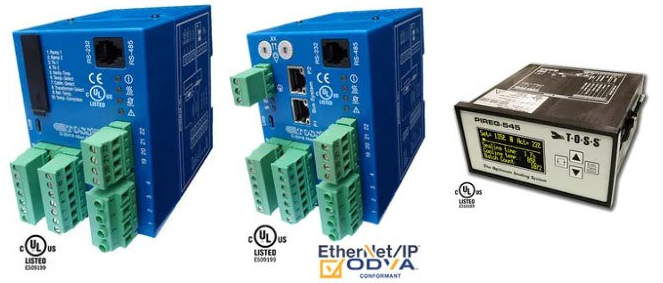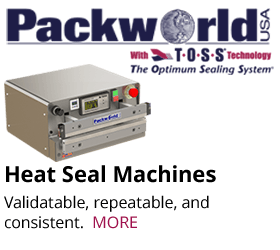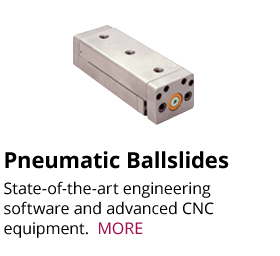-
What is impulse heat sealing?
Impulse sealing involves the electrifying of a thin strip of metal, thereby heating it up to melt layers of polymeric materials. Impulse sealing has evolved over the years from just timing the flow of electricity to placing a thermocouple against it to determine its temperature. T◆O◆S◆S® Machine Components Inc. Technology and the PIREG® temperature controller is the latest generation of control in that the heat seal bands electrical resistance is monitored and controlled; thereby eliminating the temperature lag and errors inherent in the use of thermocouples. While the PIREG® is powered ON, the resistance monitoring is continuous. This includes during the heat ramp up, the heating dwell time, the cooling phase, and while in an ambient steady state. In addition to the resistance monitoring, T◆O◆S◆S® monitors the amps flowing through the band, thereby allowing the PIREG® temperature controller to make corrections to the heat profile as fast as 60 times per second.
-
What components are needed for a T◆O◆S◆S® Impulse Heat Sealing System?
Five major components are needed: a PIREG® temperature controller, a Current Transformer, a Power Transformer (sized for the particular band(s) being heated), Heat Seal Jaw Bars with spring loaded end kits, and genuine T◆O◆S◆S® Alloy 20® heat seal bands.
-
What range of supply voltage will work with T◆O◆S◆S® systems?
Any supply voltage will work with the T◆O◆S◆S® PIREG® controllers. Voltages of 480, 520, or 600 can be accommodated.
-
How do I pick the correct T◆O◆S◆S® Controller?
The easiest way to determine the proper model is to talk to a T◆O◆S◆S® Application Expert. (610-759-8883). There are two basic categories of controllers: 1) one that gets temperature and timing signals from outside itself, via analog or serial. 2) one that has a digital screen and buttons on its face along with internal timers, so that the controller only needs a start signal and it will do the timing and setting of the heating and cooling based on what input was set on the buttons on its face.
-
How do I pick the correct T◆O◆S◆S® Custom Impulse Heat Seal Band?
There are two categories of T◆O◆S◆S® Alloy 20® custom impulse heat seal bands, 1) a band that seals and 2) a band that seals and cuts.
The cross-section profiles of bands that only seal can be tapered, flat, arched (Reflex), double seamed, or corrugated. The cross-section profile of bands that simultaneously seal and cut are shapes that have a ridge running down the top surface of the band (or just a single wire with a choice of diameters). This ridge performs the cut and the flat portion that is adjacent to this ridge will place a seal on each side of the cut.
-
Why does T◆O◆S◆S® recommend Tapered Custom Impulse Heat Seal Bands?
It is important to understand the thermodynamics of the heat seal band and how it effects the strength of seal. The centerline portion of a flat heat seal band gets hotter than the edges of the band creating a temperature gradient across the width of the band. The use of a heat seal band with tapered edges further reduces the temperature of the band at the edges and increases the gradient. This temperature gradient is desirable when making a strong seal because a cooler edge reduces the thinning of the work piece that can occur along the edge of the seal. And the seal is only as strong as the leading edge of force (the edge of the seal that force is being applied).
Another reason for recommending the tapered heat seal band is because the square edge of common bands, usually called flat bands, will tend to cut into the edge of a heat seal and cause a thinning of the work piece material. While the bonding of the materials may be adequate, the seal will be weakened and will often fail along the edge of the seal in a mode call "zippering".
-
How do I pick the correct power wire gauges for my project?
Your T◆O◆S◆S® Machine Components Inc. Application Expert will use your data to complete an applications report. This report will outline the proper sizing of all the electrical components needed for your custom application.
Wire gauges, breaker sizes, transformer sizes are all determined based on your cycle rate, incoming power, temperature requirements, band profile and other factors.
-
What is the correct closing force for my impulse heat sealing project?
On a case-by-case basis, T◆O◆S◆S® Machine Components Inc. offers free testing of your materials. Contact your T◆O◆S◆S® Application Expert and discuss what you will need to send to our lab. The tests will determine factors for sealing such as proper temperature, seal time, cooling temperature, and closing force.
The pressure applied to a seal in the field, is many times underrated, as this is the factor along with the cool down that makes the seal the strongest.
Types of devices used to apply this pressure include air cylinders, servo drives, and even manual clamping.
-
What does the TK value of a T◆O◆S◆S® Custom Impulse Heat Seal Band mean?
T◆O◆S◆S® Alloy 20® is available in two types, they are referred to as A20K and A20C. A third alloy offered by T◆O◆S◆S® is known as Norex® . Each alloy has a different relationship of its electrical resistance vs. temperature. The TK value defines this relationship to the controller so that the desired temperatures are reached for each alloy.
-
Why do some T◆O◆S◆S® Custom Impulse Heat Seal Bands need to be burned in?
Burn-In is an annealing process applied to T◆O◆S◆S® Alloy-20® to give the material a more uniform fine-grained structure. This fine-grained structure helps to stabilize the heat seal band making the controlled temperature more consistent. The burn-in process involves heating the band to 20–50°C above its intended operating sealing temperature, soaking it for a short period at that temperature and then allowing it to cool.
T◆O◆S◆S® Alloy-20K material is supplied burned in (annealed) up to an operating sealing temperature of 250°C. If your sealing temperature is higher than 250°C, you can do this when you mount it on the machine. The burn in process is found on our website. T◆O◆S◆S® Alloy-20C does NOT require burn-in.
-
Why should I consider water cooling the Heat Seal Jaw Bars?
Because ALL seals take place in the cool down and in order to achieve higher numbers of seals per minute, the cooling cycle must have assistance as the bars temperature will increase from repeated seals.
FURTHER EXPLAINATION: Due to the physical properties of sealable, polymeric materials, the seal actually takes place during the cool down. The heat seal temperatute is better defined as “the melt point” temperature. It is the temperature required to get the polymeric material to melt. The force applied to the layers of polymeric material, when at the melt point, influnces the comingling of polymers. At the end of the heating dwell time the polymers are still molten. The true seal is only complete when the material solidifies, and this takes place once the cooling portion of the cycle is complete. Hot bars (the general alternative) can supply the necessary heat but they can’t provide for cooling. Only with Impulse Sealing can you achieve the most important part of the heat sealing cycle…the “Cool Down”.
The material under the band should not be silicone thicker than 2mm. This will retard the heat movement into the cool bars during the cooling phase.
If you need to really accelerate the cooling , besides water cooling the jaws, you might consider 10mm PTFE tape under the band only. But you will need to have a softer opposite jaw bar. Hopefully after making the cooling more effiecient you still have enough horsepower in the transformer to heat the band to your sealing temperature fast enough. Usually when a customer says they want to water cool the seal, we bump up the secondary voltage (and maybe KVA), so that the band can overcome the cold jaw when it is trying to heat.
-
What is the best covering material for my Custom Impulse Heat Seal Bands?
Typically T◆O◆S◆S® recommends covering the heat seal bands with PTFE to protect the bands and create a release with the cooled-down plastic seal. There are two strategies in how tight to wrap the Cover Strip over the band, loose or tight. Sometimes a loose wrap will aid in the opening of the jaws and the sticking that may occur. If sealing at temperatures above 235°C you might want to consider Kapton as the covering.
-
How much do the T◆O◆S◆S® Custom Heat Seal Bands grow when heated?
T◆O◆S◆S® Alloy20® material will expand when heated. The higher the temperature, the more the expansion. This is why we tension the bands on the jawbars.
-
What kind of shapes can we make with T◆O◆S◆S® Custom Contour Shaped Impulse Heat Seal Bands?
With impulse sealing, a contour shape is electrified and therefore it needs a place where the electricity enters and exits. There can be no change in the cross section along this path as it will change the resistance, therefore changing the temperature. There can be no deadends, like you find in the capital letter E. As an example here are some alphabet letters that WILL work… S,U,Z,L,O (O is done by bringing the power in at 9:00 and taking it out at 3:00, thus an equal path in both CW and CCW directions). An examples of letters that will NOT work are H, A, Q, and Y .
-
Which wires need to be shielded or twisted in a T◆O◆S◆S® project?
The 18AWG UML sensing wires that connect the controller to the band definitely need to be twisted. T◆O◆S◆S® Machine Components Inc. can supply this pair of wires in a single jacket. Power wires, both primary and secondary, may need to be twisted if there are multiple controlled systems sharing the same conduits. If this is the case, you may need to twist these thicker wires as much as 20 times per meter in order to eliminate any cross talk between control systems.
-
Should I heat from one side or both sides? And what are the implications?
Heating the plastic from both sides is usually done when you are sealing two layers where each layer is greater than 5 or 6mm or you are sealing more than 2 layers as what may happen when sealing gussets or gathered areas where the layers vary from 2 or more.
-
Why does my T◆O◆S◆S® Custom Impulse Heat Seal Band ‘wrinkle” or become wavey?
This generally occures when the the heat seal band is under full jaw force as it is heating up. Like all ferrous metals, T◆O◆S◆S® Alloy-20® expands when heated. If your machine is programmed to heat the band AFTER the jaws are closed, the bands growth is being constrained by the pressure of the closed jawbar. This prohibits the spring loaded end kits from performing their intended task of keeping the heat seal band taut. It is best to bring the band up to temperature before the jaws close. You want to keep the jaw bars closed during the dwell portion of the cycle.
If the bands are long (over 24”) it is best that you drop to a lower pressure during the cool down phase so the band can contract while cooling without the pressure of the clamped jaw constraining the contraction of the band as it cools and therefore permanently stretching the band.
-
How do you seal round or boat fitments?
T◆O◆S◆S® Machine Components Inc. can lay flat bands into a recess that conforms to plastic fitments. The best fitments to use in order to achieve a great seal would be what we call boat fitments. The canoe-style profile allows an even pressure when the top and bottom convex-shaped jaws apply heat..
T◆O◆S◆S®
Sister Companies
A family of fine products for the packaging industry.
SERVING
HOURS
HOURS
CONTACT US
Main: (610) 759-8883
sales@Tossheatseal.com









Share On: